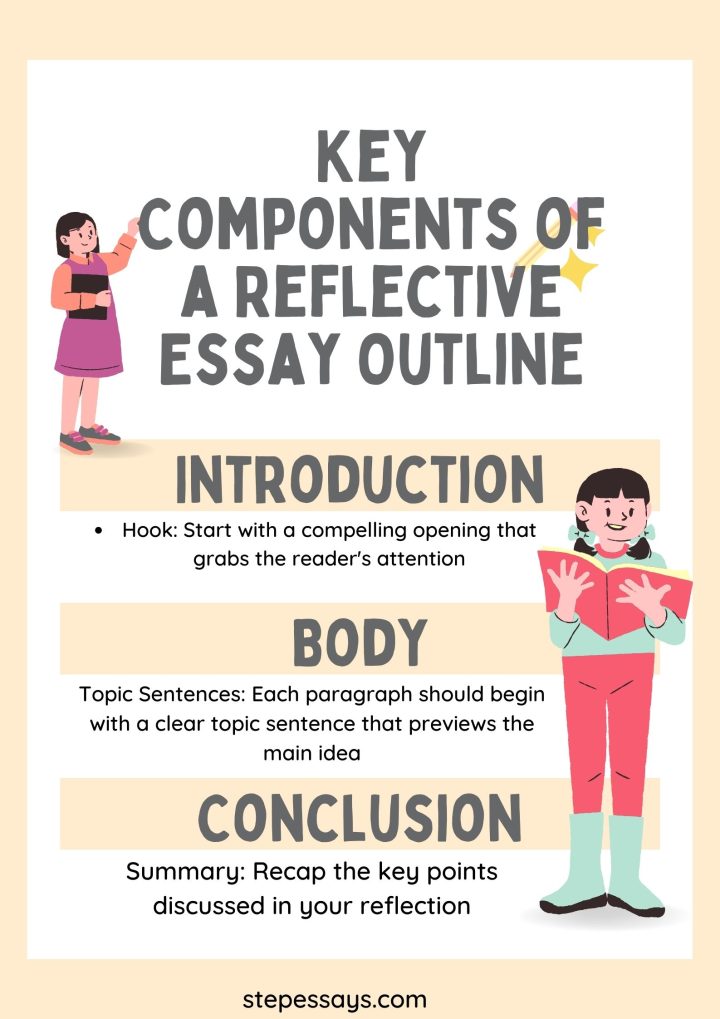Introduction
Reflective essays are unique in their approach, allowing writers to look into personal experiences, thoughts, and emotions. However, without a well-structured outline, the reflective essay can become directionless and lose its impact. Crafting the perfect outline is essential to organize thoughts, ensure coherence, and guide the narrative effectively. This guide aims to provide a comprehensive overview of how to create an ideal outline for your reflective essay.
Understanding Reflective Essays
Before diving into outlining techniques, it’s crucial to understand the essence of reflective essays. Unlike other forms of academic writing, reflective essays encourage meditation and exploration of personal experiences. They often focus on lessons learned, personal growth, or moments of realization. Reflective essays are not basically descriptive; they require critical analysis and self-reflection.
Key Components of a Reflective Essay Outline

Reflective Essay Outline
- Introduction: Setting the Stage
- Hook: Start with a compelling opening that grabs the reader’s attention.
- Contextualization: Provide necessary background information or context relevant to your reflection.
- Thesis Statement: Present the main theme or purpose of your reflection.
- Body Paragraphs: Exploring Insights
- Topic Sentences: Each paragraph should begin with a clear topic sentence that previews the main idea.
- Personal Experience: Share specific experiences or anecdotes related to your reflection.
- Analysis and Reflection: Analyze the significance of your experiences, emotions, or thoughts. Reflect on what you learned or how you grew from each experience.
- Transition: Ensure smooth transitions between paragraphs to maintain the flow of your narrative.
- Conclusion: Synthesizing Thoughts
- Summary: Recap the key points discussed in your reflection.
- Insight or Lesson Learned: Reinforce the main takeaway or lesson derived from your experiences.
- Closing Thought: End with a thought-provoking statement that leaves a lasting impression on the reader.
Creating Your Outline: Step-by-Step Guide
- Brainstorming and Reflection
- Reflect on your experiences: Identify significant moments, challenges, or turning points.
- Brainstorm ideas: Make notes of emotions, thoughts, and lessons learned from each experience.
- Prioritize key points: Determine which insights are most relevant to your reflection.
- Structuring Your Outline
- Introduction
- Hook: Anecdote, quote, question, or startling fact.
- Contextualization: Background information setting the stage for your reflection.
- Thesis Statement: Clear statement outlining the main theme or purpose.
- Body Paragraphs (usually 3-5 paragraphs)
- Topic Sentence: Preview the main idea of each paragraph.
- Personal Experience: Narrate specific events or moments.
- Analysis and Reflection: Reflect on the significance and implications of each experience.
- Transition: Connect each paragraph logically to the next.
- Conclusion
- Summary: Recap the main points discussed in the body paragraphs.
- Insight or Lesson Learned: Share the overarching lesson or insight gained.
- Closing Thought: End with a thought-provoking reflection or call to action.
- Introduction
- Adding Detail and Depth
- Flesh out each section: Expand upon your initial notes with more detail, examples, and reflections.
- Ensure coherence: Check for logical progression and consistency throughout your outline.
- Incorporate supporting evidence: If applicable, integrate relevant quotes, research, or theories to strengthen your arguments.
- Review and Revision
- Evaluate your outline: Assess the effectiveness of each section in conveying your message.
- Seek feedback: Share your outline with peers, mentors, or instructors for constructive criticism.
- Revise as needed: Make adjustments to improve clarity, coherence, and depth.
Sample Outline for a Reflective Essay
I. Introduction
- Hook: A personal anecdote about a transformative experience.
- Contextualization: Background information on the event or situation.
- Thesis Statement: Reflecting on this experience taught me valuable lessons about resilience and perseverance.
II. Body Paragraphs A. Overcoming Adversity – Topic Sentence: Despite facing numerous challenges, I persevered through adversity. – Personal Experience: Narration of specific obstacles encountered. – Analysis and Reflection: Reflection on the importance of resilience and determination. – Transition: Link to the next paragraph on personal growth.
B. Personal Growth and Development – Topic Sentence: This experience facilitated significant personal growth. – Personal Experience: Description of moments of self-discovery and growth. – Analysis and Reflection: Reflection on the lessons learned and insights gained. – Transition: Lead into the next paragraph on embracing change.
C. Embracing Change – Topic Sentence: Embracing change was crucial for navigating through uncertainty. – Personal Experience: Illustration of embracing change and adapting to new circumstances. – Analysis and Reflection: Reflection on the importance of flexibility and adaptability. – Transition: Prepare for the conclusion by summarizing key insights.
III. Conclusion
- Summary: Recap of the transformative journey and lessons learned.
- Insight or Lesson Learned: Emphasize the significance of resilience, personal growth, and adaptability.
- Closing Thought: A reflective statement on the enduring impact of the experience and the journey ahead.
Conclusion
Crafting a perfect outline for your reflective essay is essential for organizing your thoughts, guiding your narrative, and ensuring coherence. By following the steps outlined in this guide and incorporating key components into your outline, you can effectively structure your reflection and convey your insights with clarity and depth. Remember, a well-crafted outline serves as the roadmap for your reflective journey, leading both you and your readers to a deeper understanding of the experiences you wish to share.
